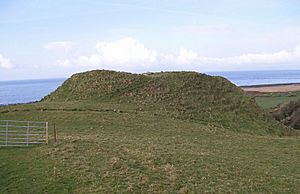Torr a'Chaisteal facts for kids

Torr a'Chaisteal
|
|
| Location | Isle of Arran |
|---|---|
| Coordinates | 55°27′32″N 5°17′19″W / 55.45897°N 5.288585°W |
| Type | Dun |
| History | |
| Periods | Iron Age |
| Site notes | |
| Ownership | Historic Scotland |
| Public access | Yes |
Torr a'Chaisteal (also called Torr a'Chaisteil) is an ancient fort from the Iron Age. It's a type of old building called a dun. You can find it about 1 mile (1.6 km) northeast of the village of Sliddery. This historic spot is on the Isle of Arran in Scotland.
Contents
What is Torr a'Chaisteal?
Torr a'Chaisteal sits on a grassy hill. It is on the west coast of the Isle of Arran. This spot was chosen because it was easy to defend.
What is a Dun?
A dun was a strong, fortified home. People built them across western Scotland during the later Iron Age. These buildings were often used by important families. They provided safety and a place to live.
How Was the Fort Built?
The walls of Torr a'Chaisteal are covered in grass. They are about 0.5 meters (1.6 feet) high. The walls are also about 4 meters (13 feet) wide on average. Large sandstone rocks were used to build these strong walls. They surround an area about 7 meters (23 feet) across.
There is a short piece of wall next to the fort on the east side. On the land side, there is a large earthwork. This might have been an extra defense. It would have made it harder for enemies to get close. Another similar dun is at Kilpatrick Dun. It is about 2.5 miles (4 km) north of Torr a'Chaisteal.
What Did People Find There?
People explored the site in the 1800s. They found some interesting things. These included human and animal bones. They also found shells and the top part of a quern. A quern was a stone used to grind grain into flour. Pieces of haematite iron were also discovered. These finds help us learn about the people who lived there long ago.


